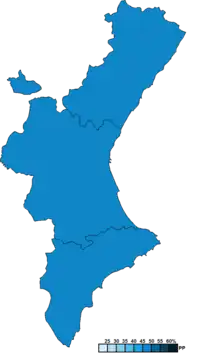1999 Valencian regional election
The 1999 Valencian regional election was held on Sunday, 13 June 1999 to elect the 5th Corts of the Valencian Community. All 89 seats in the Corts were up for election. The election was held simultaneously with regional elections in twelve other autonomous communities and local elections all throughout Spain, as well as the 1999 European Parliament election.
| |||||||||||||||||||||||||||||||||||||||||||||
All 89 seats in the Corts Valencianes 45 seats needed for a majority | |||||||||||||||||||||||||||||||||||||||||||||
|---|---|---|---|---|---|---|---|---|---|---|---|---|---|---|---|---|---|---|---|---|---|---|---|---|---|---|---|---|---|---|---|---|---|---|---|---|---|---|---|---|---|---|---|---|---|
| Opinion polls | |||||||||||||||||||||||||||||||||||||||||||||
| Registered | 3,361,989 | ||||||||||||||||||||||||||||||||||||||||||||
| Turnout | 2,279,805 (67.8%) | ||||||||||||||||||||||||||||||||||||||||||||
| |||||||||||||||||||||||||||||||||||||||||||||
 Constituency results map for the Corts Valencianes | |||||||||||||||||||||||||||||||||||||||||||||
| |||||||||||||||||||||||||||||||||||||||||||||
The People's Party (PP), which had ruled the community from 1995 in a coalition government, won an absolute majority of seats; a majority which it would maintain for the next 20 years. Its coalition partner, the Valencian Union (UV), fell just below the 5% threshold, resulting in it losing all seats and being expelled from the Courts. The Spanish Socialist Workers' Party (PSOE) remained static on its 1995 vote share, though it gained 3 additional seats thanks to United Left (IU) electoral collapse from 10 to 5 seats.
Overview
Electoral system
The Corts Valencianes were the devolved unicameral legislature of the Valencian autonomous community, having legislative power in regional matters as defined by the Spanish Constitution and the Valencian Statute of Autonomy, as well as the ability to vote confidence in or withdraw it from a regional president.[1]
Voting for the Corts was on the basis of universal suffrage, which comprised all nationals over 18 years of age, registered in the Valencian Community and in full enjoyment of their political rights. The 89 members of the Corts Valencianes were elected using the D'Hondt method and a closed list proportional representation, with a threshold of five percent of valid votes—which included blank ballots—being applied regionally. Seats were allocated to constituencies, corresponding to the provinces of Alicante, Castellón and Valencia, with each being allocated an initial minimum of 20 seats and the remaining 29 being distributed in proportion to their populations (provided that the seat-to-population ratio in any given province did not exceed three times that of any other).[1][2]
The electoral law provided that parties, federations, coalitions and groupings of electors were allowed to present lists of candidates. However, groupings of electors were required to secure the signature of at least 1 percent of the electors registered in the constituency for which they sought election. Electors were barred from signing for more than one list of candidates. Concurrently, parties and federations intending to enter in coalition to take part jointly at an election were required to inform the relevant Electoral Commission within ten days of the election being called.[2][3]
Election date
The term of the Corts Valencianes expired four years after the date of their previous election, with elections to the Corts being fixed for the fourth Sunday of May every four years. Legal amendments introduced in 1998 allowed for these to be held together with European Parliament elections, provided that they were scheduled for within a four month-timespan. The previous election was held on 28 May 1995, setting the election date for the Corts concurrently with a European Parliament election on Sunday, 13 June 1999.[1][2][3]
The Corts Valencianes could not be dissolved before the date of expiry of parliament.[1]
Opinion polls
The table below lists voting intention estimates in reverse chronological order, showing the most recent first and using the dates when the survey fieldwork was done, as opposed to the date of publication. Where the fieldwork dates are unknown, the date of publication is given instead. The highest percentage figure in each polling survey is displayed with its background shaded in the leading party's colour. If a tie ensues, this is applied to the figures with the highest percentages. The "Lead" column on the right shows the percentage-point difference between the parties with the highest percentages in a poll. When available, seat projections determined by the polling organisations are displayed below (or in place of) the percentages in a smaller font; 45 seats were required for an absolute majority in the Corts Valencianes.
| Polling firm/Commissioner | Fieldwork date | Sample size | Turnout | Lead | |||||
|---|---|---|---|---|---|---|---|---|---|
| 1999 regional election | 13 Jun 1999 | — | 67.8 | 47.9 49 |
33.9 35 |
6.1 5 |
4.7 0 |
4.5 0 |
14.0 |
| Eco Consulting/ABC[p 1] | 24 May–2 Jun 1999 | ? | ? | 42.5 43/45 |
30.3 30/31 |
12.5 10/11 |
7.0 5 |
– | 12.2 |
| Demoscopia/El País[p 2] | 26 May–1 Jun 1999 | ? | 69 | 49.0 48/50 |
32.0 31/33 |
9.9 5/7 |
5.2 0/4 |
3.6 0 |
17.0 |
| Sigma Dos/El Mundo[p 3][p 4] | 20–26 May 1999 | 1,200 | ? | 48.7 47/50 |
33.2 31/34 |
8.5 7 |
4.9 0/2 |
– | 15.5 |
| CIS[p 5][p 6][p 7] | 3–20 May 1999 | 2,100 | 75.1 | 48.1 46/49 |
31.9 31/33 |
9.5 7/8 |
5.1 0/4 |
3.2 0 |
16.2 |
| Tele 5[p 8] | 4 May 1999 | ? | ? | 49.0 46/48 |
34.0 32/34 |
7.0 5 |
3.0 0 |
5.0 2/4 |
15.0 |
| 1996 general election | 3 Mar 1996 | — | 81.7 | 43.7 (42) |
38.3 (38) |
11.1 (9) |
3.5 (0) |
1.0 (0) |
5.4 |
| 1995 regional election | 28 May 1995 | — | 76.0 | 42.8 42 |
34.0 32 |
11.5 10 |
7.0 5 |
2.7 0 |
8.8 |
Results
Overall
 | ||||||
| Parties and alliances | Popular vote | Seats | ||||
|---|---|---|---|---|---|---|
| Votes | % | ±pp | Total | +/− | ||
| People's Party (PP) | 1,085,011 | 47.88 | +5.05 | 49 | +7 | |
| Spanish Socialist Workers' Party–Progressives (PSOE–p) | 768,548 | 33.91 | –0.07 | 35 | +3 | |
| United Left of the Valencian Country (EUPV) | 137,212 | 6.05 | –5.48 | 5 | –5 | |
| Valencian Union (UV) | 106,119 | 4.68 | –2.33 | 0 | –5 | |
| Valencian Nationalist Bloc–The Greens (BNV–EV)1 | 102,700 | 4.53 | +1.82 | 0 | ±0 | |
| Valencian Community Alternative (ACV) | 6,146 | 0.27 | New | 0 | ±0 | |
| Liberal Centre (CL) | 4,813 | 0.21 | New | 0 | ±0 | |
| The Ecologist–Pacifist Greens (LVEP) | 4,176 | 0.18 | New | 0 | ±0 | |
| Centrist Union–Democratic and Social Centre (UC–CDS) | 2,978 | 0.13 | –0.10 | 0 | ±0 | |
| Spanish Phalanx of the CNSO (FE–JONS) | 2,973 | 0.13 | +0.06 | 0 | ±0 | |
| Independent Initiative (II) | 2,524 | 0.11 | New | 0 | ±0 | |
| Humanist Party (PH) | 2,253 | 0.10 | +0.07 | 0 | ±0 | |
| Valencian Nationalist Left (ENV) | 2,070 | 0.09 | +0.01 | 0 | ±0 | |
| Federal Republican Left–Federal Republican Party (IRF–PRF) | 1,660 | 0.07 | New | 0 | ±0 | |
| Valencian Independent Organization (OIV) | 1,316 | 0.06 | New | 0 | ±0 | |
| Spanish Autonomous League (LAE) | 608 | 0.03 | +0.01 | 0 | ±0 | |
| Blank ballots | 35,168 | 1.55 | +0.50 | |||
| Total | 2,266,275 | 89 | ±0 | |||
| Valid votes | 2,266,275 | 99.41 | –0.03 | |||
| Invalid votes | 13,530 | 0.59 | +0.03 | |||
| Votes cast / turnout | 2,279,805 | 67.81 | –8.22 | |||
| Abstentions | 1,082,184 | 32.19 | +8.22 | |||
| Registered voters | 3,361,989 | |||||
| Sources[4][5][6] | ||||||
Footnotes:
| ||||||
Aftermath
Government formation
| Investiture | |||||
| Candidate | Ballot → | 16 July 1999 | |||
|---|---|---|---|---|---|
| Required majority → | 45 out of 89 | ||||
| Eduardo Zaplana (PP) | Yes
|
49 / 89 |
|||
40 / 89 | |||||
| Abstentions | 0 / 89 | ||||
| Absentees | 0 / 89 | ||||
| Antoni Asunción (PSOE) | |||||
| Joan Ribó (EUPV) | |||||
| Sources[6] | |||||
References
- Opinion poll sources
- "Zaplana roza la mayoría absoluta al restar al menos un diputado al PSOE". ABC (in Spanish). 7 June 1999.
- "Zaplana alcanza la mayoría absoluta". El País (in Spanish). 7 June 1999.
- "Comunidad Valenciana: el nacionalismo se deshincha". El Mundo (in Spanish). 30 May 1999.
- "ELECCIONES 13-J/BALANCE DE LAS ENCUESTAS". El Mundo (in Spanish). 6 June 1999.
- "Preelectoral elecciones autonómicas y municipales, 1999. Comunidad Valenciana (Estudio nº 2338. Mayo 1999)". CIS (in Spanish). 4 June 1999.
- "Estudio CIS nº 2338. Ficha técnica" (PDF). CIS (in Spanish). 4 June 1999.
- "Bono e Ibarra repiten y el PSOE recuperará Asturias". La Vanguardia (in Spanish). 5 June 1999.
- "Una encuesta da al PP la mayoría absoluta y otorga escaños al BNV". El País (in Spanish). 4 May 1999.
- Other
- "Ley Orgánica 5/1982, de 1 de julio, de Estatuto de Autonomía de la Comunidad Valenciana". Organic Law No. 1 of 1 July 1982 (in Spanish). Retrieved 17 March 2017.
- "Ley 1/1987, de 31 de marzo, Electoral Valenciana". Law No. 2 of 31 March 1987 (in Spanish). Retrieved 17 March 2017.
- "Ley Orgánica 5/1985, de 19 de junio, del Régimen Electoral General". Organic Law No. 5 of 19 June 1985 (in Spanish). Retrieved 28 December 2016.
- "Electoral Results. Electoral Data - Regional Election: 1999". www.cortsvalencianes.es (in Spanish). Valencian Government. Retrieved 29 November 2019.
- "Corts Valencianes election results, 13 June 1999" (PDF). www.juntaelectoralcentral.es (in Spanish). Electoral Commission of the Valencian Community. 5 July 1999. Retrieved 30 September 2017.
- "Eleccions a les Corts Valencianes (1983 - 2019)". Historia Electoral.com (in Spanish). Retrieved 30 September 2017.
.jpg.webp)
.jpg.webp)
.JPG.webp)